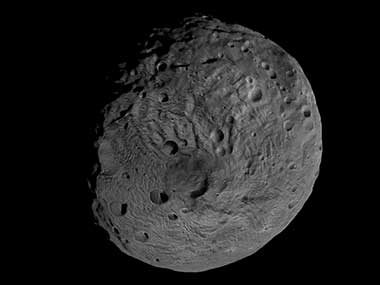Scientists have found a carbon-rich asteroid that was flung into the outer reaches of the solar system and may provide new insights into the formation of the Sun and its planets. Astronomers used European Southern Observatory (ESO) telescopes to investigate Kuiper Belt Object 2004 EW95, the first of its kind asteroid to be confirmed in the cold outer reaches of the solar system. [caption id=“attachment_832197” align=“alignleft” width=“380”]  Representational image. Reuters[/caption] The object likely formed in the asteroid belt between Mars and Jupiter and has been flung billions of kilometres from its origin to its current home in the Kuiper Belt . The early days of our Solar System were a tempestuous time. Theoretical models of this period predict that after the gas giants formed they rampaged through the solar system, ejecting small rocky bodies from the inner solar system to far-flung orbits at great distances from the Sun. These models suggest that the Kuiper Belt, a cold region beyond the orbit of Neptune, should contain a small fraction of rocky bodies from the inner Solar System, such as carbon-rich asteroids, referred to as carbonaceous asteroids. The study found evidence for the first reliably-observed carbonaceous asteroid in the Kuiper Belt, providing strong support for these theoretical models of our Solar System’s troubled youth. After measurements from multiple instruments at ESO’s Very Large Telescope (VLT), astronomers led by Tom Seccull of Queen’s University Belfast in the UK were able to measure the composition of the anomalous Kuiper Belt Object 2004 EW95, and thus determine that it is a carbonaceous asteroid. This suggests that it originally formed in the inner Solar System and must have since migrated outwards. The peculiar nature of 2004 EW95 first came to light during routine observations with the NASA/ESA Hubble Space Telescope by Wesley Fraser, an astronomer from Queen’s University Belfast who was also a member of the team behind this discovery. The asteroid’s reflectance spectrum, the specific pattern of wavelengths of light reflected from an object, was different to that of similar small Kuiper Belt Objects (KBOs), which typically have uninteresting, featureless spectra that reveal little information about their composition. “The reflectance spectrum of 2004 EW95 was clearly distinct from the other observed outer Solar System objects. It looked enough of a weirdo for us to take a closer look,” said Seccull. The team observed 2004 EW95 with the X-Shooter and FORS2 instruments on the VLT. The sensitivity of these spectrographs allowed the team to obtain more detailed measurements of the pattern of light reflected from the asteroid and thus infer its composition. However, even with the impressive light-collecting power of the VLT, 2004 EW95 was still difficult to observe. Though the object is 300 kilometers across, it is currently a colossal four billion kilometers from Earth, making gathering data from its dark, carbon-rich surface a demanding scientific challenge. Two features of the object’s spectra were particularly eye-catching and corresponded to the presence of ferric oxides and phyllosilicates. The presence of these materials had never before been confirmed in a KBO, and they strongly suggest that 2004 EW95 formed in the inner Solar System. “Given 2004 EW95’s present-day abode in the icy outer reaches of the Solar System, this implies that it has been flung out into its present orbit by a migratory planet in the early days of the Solar System,” said Seccull
The object likely formed in the asteroid belt between Mars and Jupiter and has been flung billions of kilometres from its origin to its current home in the Kuiper Belt.
Advertisement
End of Article


)
)
)
)
)
)
)
)
)



